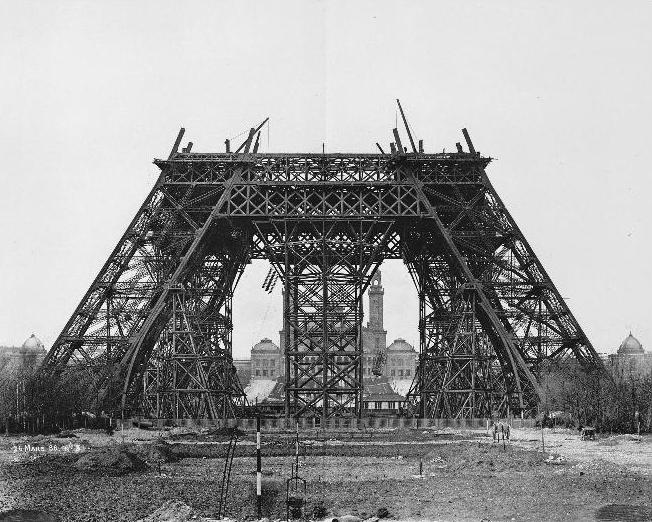Eiffel Tower Elevator
***PLEASE NOTE: BLOG IN PROGRESS***Equipping the Eiffel Tower with safe passenger lifts was a major concern of the government commission overseeing the Paris Exposition. Although some visitors could be expected to climb to the first level, or even the second, lifts clearly had to be the main means of ascent.
Constructing lifts to reach the first level was relatively straightforward: the legs were wide enough at the bottom and so nearly straight that they could contain a straight track, and a contract was given to the French company Roux, Combaluzier & Lepape for two lifts to be fitted in the east and west legs. Roux, Combaluzier & Lepape used a pair of endless chains with rigid, articulated links to which the car was attached. Lead weights on some links of the upper or return sections of the chains counterbalanced most of the car's weight. The car was pushed up from below, not pulled up from above: to prevent the chain buckling, it was enclosed in a conduit. At the bottom of the run, the chains passed around 3.9 m (12 ft 10 in) diameter sprockets. Smaller sprockets at the top guided the chains.
Installing lifts to the second level was more of a challenge because a straight track was impossible. No French company wanted to undertake the work. The European branch of Otis Brothers & Company submitted a proposal but this was rejected: the fair's charter ruled out the use of any foreign material in the construction of the tower. The deadline for bids was extended but still no French companies put themselves forward, and eventually the contract was given to Otis in July 1887. Otis were confident they would eventually be given the contract and had already started creating designs.
The car was divided into two superimposed compartments, each holding 25 passengers, with the lift operator occupying an exterior platform on the first level. Motive power was provided by an inclined hydraulic ram 12.67 m (41 ft 7 in) long and 96.5 cm (38.0 in) in diameter in the tower leg with a stroke of 10.83 m (35 ft 6 in): this moved a carriage carrying six sheaves. Five fixed sheaves were mounted higher up the leg, producing an arrangement similar to a block and tackle but acting in reverse, multiplying the stroke of the piston rather than the force generated. The hydraulic pressure in the driving cylinder was produced by a large open reservoir on the second level. After being exhausted from the cylinder, the water was pumped back up to the reservoir by two pumps in the machinery room at the base of the south leg. This reservoir also provided power to the lifts to the first level.
The original lifts for the journey between the second and third levels were supplied by Léon Edoux. A pair of 81 m (266 ft) hydraulic rams were mounted on the second level, reaching nearly halfway up to the third level. One lift car was mounted on top of these rams: cables ran from the top of this car up to sheaves on the third level and back down to a second car. Each car only travelled half the distance between the second and third levels and passengers were required to change lifts halfway by means of a short gangway. The 10-ton cars each held 65 passengers.
1_
Contemporary illustration of the third level lifts in the Eiffel Tower
Poyet, published in La Nature, May 4, 1889, vol. 17, p. 361
Constructed from 1887–1889 as the entrance to the 1889 World's Fair, The Eiffel Tower is a wrought-iron lattice tower on the Champ de Mars in Paris, France. It is named after the engineer Gustave Eiffel, whose company designed and built the tower.
The tower is 324 metres (1,063 ft) tall, about the same height as an 81-storey building, and the tallest structure in Paris. Its base is square, measuring 125 metres (410 ft) on each side.
First drawing of the Eiffel Tower by Maurice Koechlin including size comparison with other Parisian landmarks such as Notre Dame de Paris, the Statue of Liberty and the Vendôme Column










